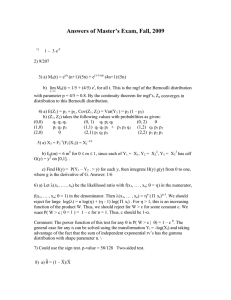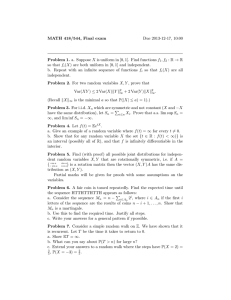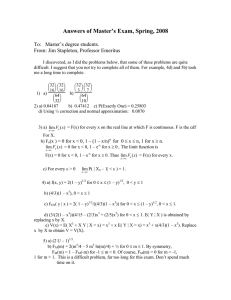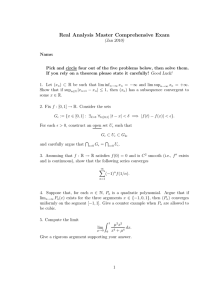Answers of Master’s Exam, Spring, 2007
advertisement
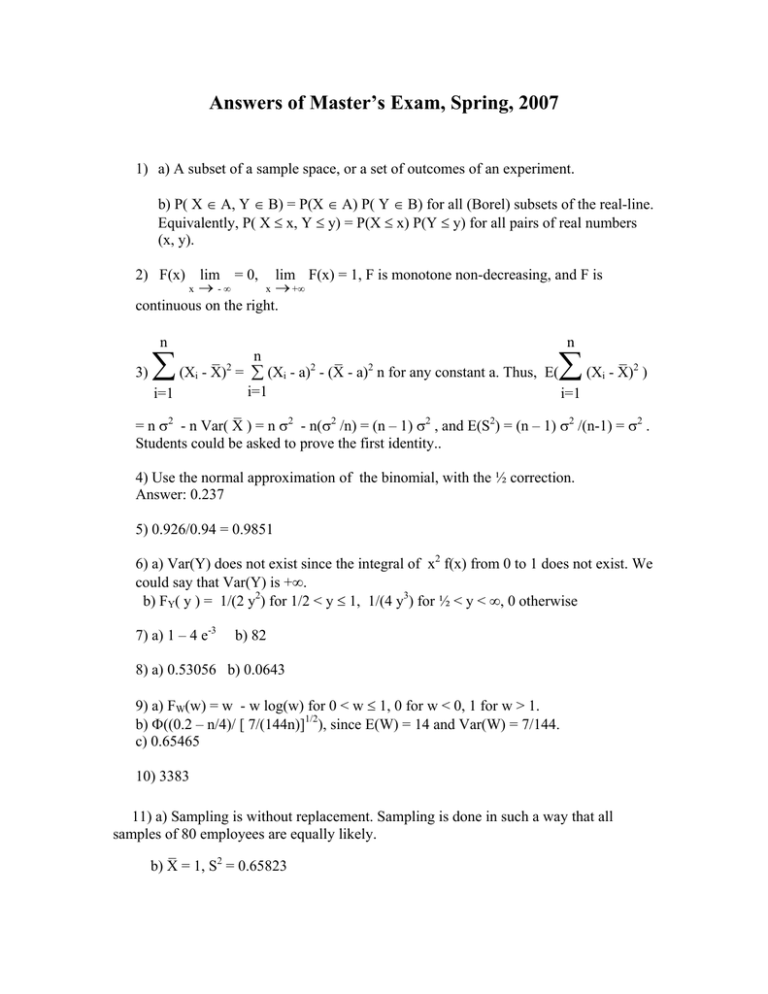
Answers of Master’s Exam, Spring, 2007
1) a) A subset of a sample space, or a set of outcomes of an experiment.
b) P( X ∈ A, Y ∈ B) = P(X ∈ A) P( Y ∈ B) for all (Borel) subsets of the real-line.
Equivalently, P( X ≤ x, Y ≤ y) = P(X ≤ x) P(Y ≤ y) for all pairs of real numbers
(x, y).
2) F(x) lim = 0, lim F(x) = 1, F is monotone non-decreasing, and F is
x → -∞
x → +∞
continuous on the right.
n
n
n
_
_
_
(Xi - X)2 = ∑ (Xi - a)2 - (X - a)2 n for any constant a. Thus, E(
(Xi - X)2 )
3)
i=1
i=1
i=1
_
= n σ2 - n Var( X ) = n σ2 - n(σ2 /n) = (n – 1) σ2 , and E(S2) = (n – 1) σ2 /(n-1) = σ2 .
Students could be asked to prove the first identity..
∑
∑
4) Use the normal approximation of the binomial, with the ½ correction.
Answer: 0.237
5) 0.926/0.94 = 0.9851
6) a) Var(Y) does not exist since the integral of x2 f(x) from 0 to 1 does not exist. We
could say that Var(Y) is +∞.
b) FY( y ) = 1/(2 y2) for 1/2 < y ≤ 1, 1/(4 y3) for ½ < y < ∞, 0 otherwise
7) a) 1 – 4 e-3
b) 82
8) a) 0.53056 b) 0.0643
9) a) FW(w) = w - w log(w) for 0 < w ≤ 1, 0 for w < 0, 1 for w > 1.
b) Φ((0.2 – n/4)/ [ 7/(144n)]1/2), since E(W) = 14 and Var(W) = 7/144.
c) 0.65465
10) 3383
11) a) Sampling is without replacement. Sampling is done in such a way that all
samples of 80 employees are equally likely.
_
b) X = 1, S2 = 0.65823
c) 0.0049615
d) 200 ± 27.612
e) The sampling and the interval were determined in such a way that 95% of all
possible samples produce intervals which contain the population total T.
_
12) a) Reject H0 for X ≥ 43.29
b) 0.8037
c) [37.966, 48.034]
_
_
13) a) θ^ = X/(1 + X).
^
b) lim P( | θn - θ | < ε | θ ) = 1 for every ε > 0, for each θ in the parameter
n→ ∞
space.
_
c) By the weak law of large numbers Xn converges in probability to the mean μ.
Since θ = μ/(1 + μ) is a continuous function of μ, θ^ converges in probability to
θ.
n
_
d) Let Yi = log(Xi). The MLE is n/Σ Yi = 1/Y.
14) a) The first column: 0.36, 9, 6/7 Second column: 9, 9/4, 3/14
Third column: 6/7, 3/14, 1/49
b) Reject for (x1, x2) in {{1,1}, (1,2), (2,1), (2,2)}
c) Power o.81
^ ‘ = (3, 2, 1)
15) a) β
b) 4
c) 5/2
d) 2 ± 6.80
16) Suppose that Di is (A value – B value for plot i), with the Di independent, each
with the N( μD, σD2) distribution, with μD, σD2 unknown. We wish to test H0:
μD ≤ 0, vs Ha: μD > 0.
_
We observe D1 = 2, D2 = 3, D3 = 2, D4 = 5, D5 = 3, D = 3, SD2 = 6/4 = 1.5
T = (3 - 0)/[1.5/5]1/2 = 5.477. Reject for T > 2.132, so we reject H0.
⎛32⎞ ⎛32⎞
⎜ ⎟⎜ ⎟
⎝16⎠ ⎝16⎠
) a)
⎛64⎞
⎜ ⎟
⎝32⎠
lim Fn ( x)
n →∞
3) a) Mn(t) = et/n (n+1)/(5n) + e(1-1/n)t (4n+1)/(5n)
b) lim Mn(t) = 1/5 + (4/5) et, for all t. This is the mgf of the Bernoulli distribution
n→∞
with parameter p = 4/5 = 0.8. By the continuity theorem for mgf’s, Zn converges in
distribution to this Bernoulli distribution.
4) a) E(Z1) = p1 + p3., Cov(Z1, Z2) = Var(Y3 ) = p3 (1 – p3)
b) (Z1, Z2) takes the following values with probabilities as given:
(0,0)
q1 q2 q3
(0, 1) q1 p2 q3
(0, 2)
0
(1,0)
p1 q2 p3
(1,1) q1 q2 p3 + p1 p2 q3 (1,2) q1 p2 p3
(2,0)
0
(2,1) p1 q2 p3
(2,2) p1 p2 p3
5) a) X3 = F3-1(F1(X1)) = X1-1/3
b) fM(m) = 6 m6 for 0 ≤ m ≤ 1, since each of Y1 = X1, Y2 = X22, Y3 = X33 has cdf
G(y) = y2 on [0,1]. .
c) Find H(y) = P(Y1 – Y2 . > y) for each y, then integrate H(y) g(y) from 0 to one,
where g is the derivative of G. Answer: 1/6
6) a) Let λ(x1, … , xn) be the likelihood ratio with f(x1, … , xn; θ = η) in the numerator,
f(x1, … , xn; θ = 1) in the denominator. Then λ(x1, … , xn) = ηn ( Π xi)η-1. We should
reject for large log(λ) = n log(η) + (η - 1) log( Π xi) . For η > 1, this is an increasing
function of the product W. Thus, we should reject for W > c for some constant c. We
want P( W > c | θ = 1 ) = 1 – c for n = 1. Thus, c should be 1-α.
Comment: The power function of this test for any θ is P( W > c | θ) = 1 – c θ. The
general case for any n can be solved using the transformation Yi = -log(Xi) and taking
advantage of the fact that the sum of independent exponential rv’s has the gamma
distribution with shape parameter n. \
7) Could use the sign test. p-value = 58/128 Two-sided test.
_ _
8) a) θ^ = (1 – X)/X
_
b) θ^MLE = Y, where Yi = -log( Xi ) for each i.
c)
_
Each Yi has the exponential distribution with mean θ. Thus E(Y ) = θ. Answer: Yes
^ for i =
9) a) Let Q( β1, β2) = Σ (Y1j - β1)2 + Σ (Y2j - β2)2. Differentiating wrt to βi we get β
i
1, 2.
^ -β
^ ) = β - β , Var(β
^ -β
^ ) = σ2(1/n + 1/n ).
b) E(β
1
2
1
2
1
2
1
2
c) For σ2 = 10, the Z statistic is -2.6/[10(1/5 + 1/5)] = -1.3, so the p-value for a one
sided test is P(Z ≤ -1.3 ) =. 0.10. Do not reject H .
0
